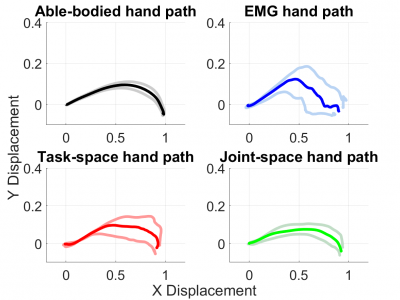Wearable Sensing
Synergistic prostheses enable the coordinated movement of the human-prosthetic arm, as required by activities of daily living. This is achieved by coupling the motion of the prosthesis to the human command, such as residual limb movement in motion-based interfaces. Previous studies demonstrated that developing human-prosthetic synergies in joint-space must consider individual motor behaviour and the intended task to be performed, requiring personalisation and task calibration.
- Categories:
 448 Views
448 Views
Ear-EEG recording collects brain signals from electrodes placed in the ear canal. Compared with existing scalp-EEG, ear-EEG is more wearable and user-comfortable compared with existing scalp-EEG.
- Categories:
 2564 Views
2564 ViewsThis dataset features cooking activities with recipes and gestures labeled. The data has been collected using two smartphones (right arm and left hip), two smartwatches (both wrists) and one motion capture system with 29 markers. There were 4 subjects who prepared 3 recipes (sandwich, fruit salad, cereal) 5 times each. The subjects followed a script for each recipe but acted as naturally as possible
- Categories:
 2406 Views
2406 Views
BS-HMS-Dataset is a dataset of the users' brainwave signals and the corresponding hand movement signals from a large number of volunteer participants. The dataset has two parts; (1) Neurosky based Dataset (collected over several months in 2016 from 32 volunteer participants), and (2) Emotiv based Dataset (collected from 27 volunteer participants over several months in 2019).
- Categories:
 4153 Views
4153 ViewsWe provide a large benchmark dataset consisting of about: 3.5 million keystroke events; 57.1 million data-points for accelerometer and gyroscope each; and 1.7 million data-points for swipes. Data was collected between April 2017 and June 2017 after the required IRB approval. Data from 117 participants, in a session lasting between 2 to 2.5 hours each, performing multiple activities such as: typing (free and fixed text), gait (walking, upstairs and downstairs) and swiping activities while using desktop, phone and tablet is shared.
- Categories:
 10877 Views
10877 ViewsThis dataset comprises supplementary materials to accompany "Flexible Iridium Oxide based pH sensor Integrated with Inductively Coupled Wireless Transmission System for Wearable Applications" by Marsh et al. Included are processing details and images, collected calibration data, and analysis procedures.
- Categories:
 320 Views
320 ViewsThis study was conducted in Mayaguez – Puerto Rico, and an area of around 18 Km2 was covered, which were determined using the following classification of places:
· Main Avenues: Wide public ways that has hospitals, vegetation, buildings, on either side
· Open Places: Mall parking lots and public plazas
· Streets & Roads: Dense residential and commercial areas on both sides
Vendor Equipment Description
KEYSIGHT® N9343C Handheld Spectrum Analyzer
- Categories:
 842 Views
842 ViewsThis database contains the results of an experiment were healthy subjects played 5 trials of a rehabilitation-based VR game, to experience either difficulty variations or presence variations.
Colected results are demogrpahic information, emotional emotions after each trial and electrophysiological signals during all 5 trials.
- Categories:
 613 Views
613 Views





